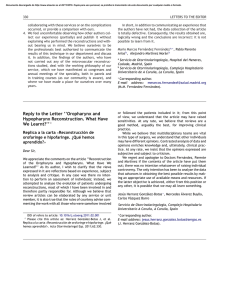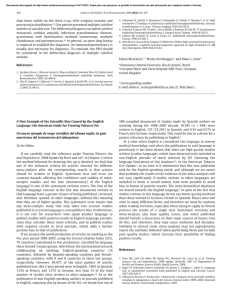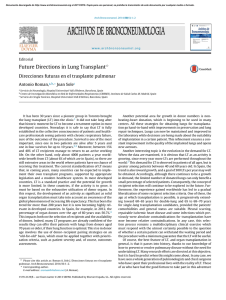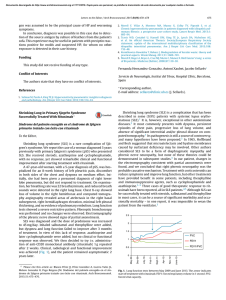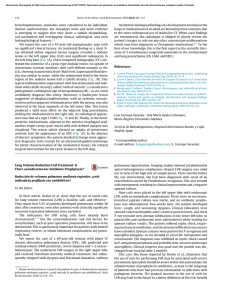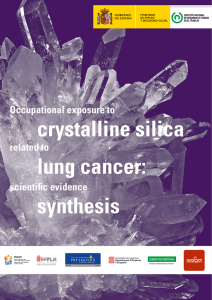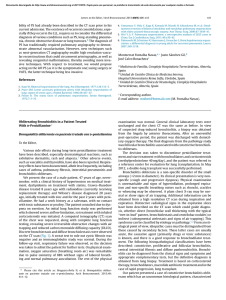Guidelines for the Diagnosis and Monitoring of Silicosis
Anuncio
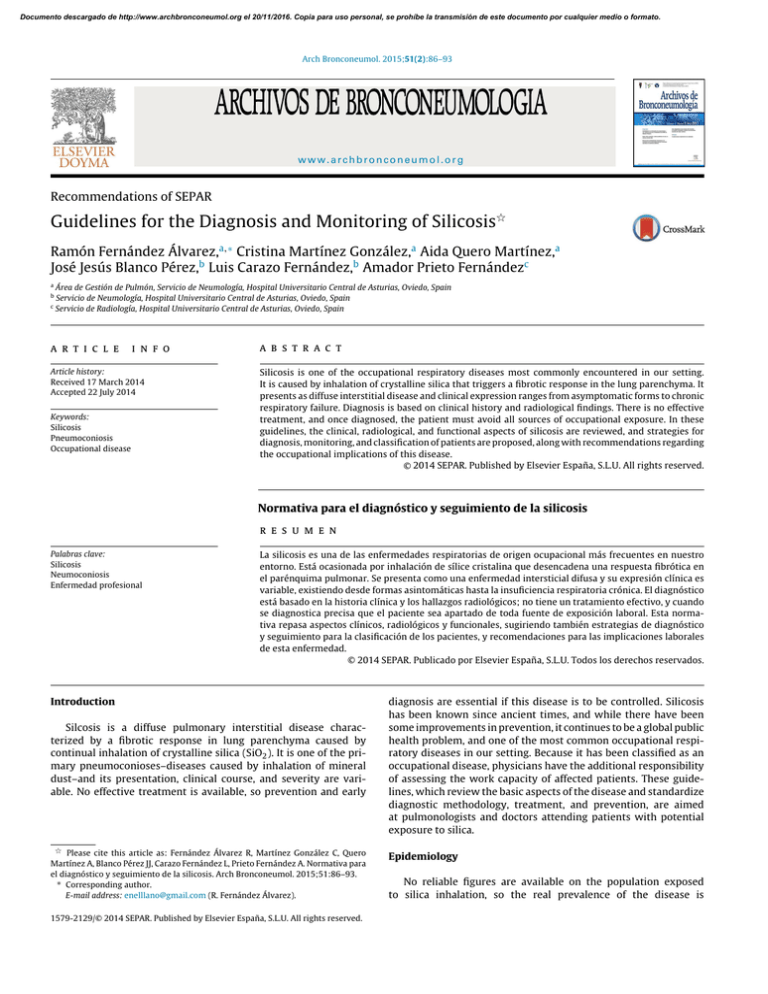
Documento descargado de http://www.archbronconeumol.org el 20/11/2016. Copia para uso personal, se prohíbe la transmisión de este documento por cualquier medio o formato. Arch Bronconeumol. 2015;51(2):86–93 www.archbronconeumol.org Recommendations of SEPAR Guidelines for the Diagnosis and Monitoring of Silicosis夽 Ramón Fernández Álvarez,a,∗ Cristina Martínez González,a Aida Quero Martínez,a José Jesús Blanco Pérez,b Luis Carazo Fernández,b Amador Prieto Fernándezc a b c Área de Gestión de Pulmón, Servicio de Neumología, Hospital Universitario Central de Asturias, Oviedo, Spain Servicio de Neumología, Hospital Universitario Central de Asturias, Oviedo, Spain Servicio de Radiología, Hospital Universitario Central de Asturias, Oviedo, Spain a r t i c l e i n f o Article history: Received 17 March 2014 Accepted 22 July 2014 Keywords: Silicosis Pneumoconiosis Occupational disease a b s t r a c t Silicosis is one of the occupational respiratory diseases most commonly encountered in our setting. It is caused by inhalation of crystalline silica that triggers a fibrotic response in the lung parenchyma. It presents as diffuse interstitial disease and clinical expression ranges from asymptomatic forms to chronic respiratory failure. Diagnosis is based on clinical history and radiological findings. There is no effective treatment, and once diagnosed, the patient must avoid all sources of occupational exposure. In these guidelines, the clinical, radiological, and functional aspects of silicosis are reviewed, and strategies for diagnosis, monitoring, and classification of patients are proposed, along with recommendations regarding the occupational implications of this disease. © 2014 SEPAR. Published by Elsevier España, S.L.U. All rights reserved. Normativa para el diagnóstico y seguimiento de la silicosis r e s u m e n Palabras clave: Silicosis Neumoconiosis Enfermedad profesional La silicosis es una de las enfermedades respiratorias de origen ocupacional más frecuentes en nuestro entorno. Está ocasionada por inhalación de sílice cristalina que desencadena una respuesta fibrótica en el parénquima pulmonar. Se presenta como una enfermedad intersticial difusa y su expresión clínica es variable, existiendo desde formas asintomáticas hasta la insuficiencia respiratoria crónica. El diagnóstico está basado en la historia clínica y los hallazgos radiológicos; no tiene un tratamiento efectivo, y cuando se diagnostica precisa que el paciente sea apartado de toda fuente de exposición laboral. Esta normativa repasa aspectos clínicos, radiológicos y funcionales, sugiriendo también estrategias de diagnóstico y seguimiento para la clasificación de los pacientes, y recomendaciones para las implicaciones laborales de esta enfermedad. © 2014 SEPAR. Publicado por Elsevier España, S.L.U. Todos los derechos reservados. Introduction Silcosis is a diffuse pulmonary interstitial disease characterized by a fibrotic response in lung parenchyma caused by continual inhalation of crystalline silica (SiO2 ). It is one of the primary pneumoconioses–diseases caused by inhalation of mineral dust–and its presentation, clinical course, and severity are variable. No effective treatment is available, so prevention and early 夽 Please cite this article as: Fernández Álvarez R, Martínez González C, Quero Martínez A, Blanco Pérez JJ, Carazo Fernández L, Prieto Fernández A. Normativa para el diagnóstico y seguimiento de la silicosis. Arch Bronconeumol. 2015;51:86–93. ∗ Corresponding author. E-mail address: enelllano@gmail.com (R. Fernández Álvarez). 1579-2129/© 2014 SEPAR. Published by Elsevier España, S.L.U. All rights reserved. diagnosis are essential if this disease is to be controlled. Silicosis has been known since ancient times, and while there have been some improvements in prevention, it continues to be a global public health problem, and one of the most common occupational respiratory diseases in our setting. Because it has been classified as an occupational disease, physicians have the additional responsibility of assessing the work capacity of affected patients. These guidelines, which review the basic aspects of the disease and standardize diagnostic methodology, treatment, and prevention, are aimed at pulmonologists and doctors attending patients with potential exposure to silica. Epidemiology No reliable figures are available on the population exposed to silica inhalation, so the real prevalence of the disease is Documento descargado de http://www.archbronconeumol.org el 20/11/2016. Copia para uso personal, se prohíbe la transmisión de este documento por cualquier medio o formato. 87 R. Fernández Álvarez et al. / Arch Bronconeumol. 2015;51(2):86–93 La Coruña Asturias Biscay Lugo Guipúzcoa Orense Pontevedra León Palencia Valladolid Zamora Barcelona Teruel Salamanca Castellón Badajoz Murcia Córdoba Almería Fig. 1. Provinces in which new cases of silicosis were diagnosed (2012). Table 1 New Diagnoses of Silicosis. Year 2003 2004 2005 2006 2007 2008 2009 2010 2011 2012 Number 375 264 224 151 115 134 165 220 256 166 Source: Reports and statistics of new silicosis cases registered in the National Silicosis Institute (2008–2013).6 unknown. However, epidemiological relevance can be estimated from databases such as the CAREX registry. In 2000, this registry recorded 3.2 million individuals exposed to silica in the European Union. In Spain in 2004, 1.2 million workers, particularly in the construction sector, were exposed to this risk.1 In Spain, varying prevalences have been reported from crosssectional studies conducted in industries where there is a risk of silica inhalation: 47.5% in granite quarries in El Escorial (1990),2 6% in underground fluorite mines in Asturias (1993),3 6% in the slate industry in Galicia (1994),4 and 6% in granite works in Extremadura.5 In the annual reports of the National Silicosis Institute, the disease is listed as occurring in most of the autonomous communities of Spain, although data from some regions are not available6 (Fig. 1). Since 2008, the number of new diagnoses has increased in industries other than coal mining, such as granite, slate, and artificial silica conglomerate works. This phenomenon may reflect changes in the incidence of the disease or factors derived from socioeconomic circumstances (Table 1). Causes and Risk Factors Causes Silicosis is caused by the inhalation of crystalline silica, including quartz (the most abundant in nature), cristobalite, and trimidite. Sources of exposure are almost exclusively occupational (Table 2) and are numerous, as silica is found in varying proportions in many minerals. In principle, anyone working in processes involving earth works or products containing silica, such as building or masonry and cement work can be exposed to silica. In our setting, we see a high proportion of quarry workers and ornamental stone cutters (granite and slate). Moreover, in recent years, cases of silicosis have been described in artificial stone workers exposed to dust generated from the handling of quartz conglomerates widely used in interior decoration, kitchens, and bathrooms that have a crystalline silica content of between 70% and 90%.7 Environmental exposure to respirable crystalline silica may be significantly higher in the vicinity of industrial sources of dust, such as quarries and sand works, and cases of non-occupational silicosis have been reported in communities living close to such places.8 Table 2 Main Occupations With Exposure to Crystalline Silica. Excavations in mines, tunnels, quarries, underground galleries Quarrying, cutting and polishing siliceous rock Dry cutting, grinding, sieving and manipulation of minerals and rock Manufacture of silicon carbide, glass, porcelain, earthenware and other ceramic products Manufacture and maintenance of abrasives and detergent powders Foundry work: cast shakeout, sprue removal and blast cleaning Milling work: polishing, filing products containing free silica Sandblasting and grinding Pottery industry Handling quartz conglomerates and ornamental stone Dental prostheses Documento descargado de http://www.archbronconeumol.org el 20/11/2016. Copia para uso personal, se prohíbe la transmisión de este documento por cualquier medio o formato. 88 R. Fernández Álvarez et al. / Arch Bronconeumol. 2015;51(2):86–93 Table 3 Clinical Forms of Silicosis. Clinical form Time of exposure Radiology Symptoms Lung function Simple chronic Complicated chronic >10 years >10 years Nodules <10 mm Masses >1 cm None Dyspnea, Cough Interstitial pulmonary fibrosis Accelerated >10 years Dyspnea, Cough 5–10 years Acute <5 years Diffuse reticulonodular pattern Rapidly progressing nodules and masses Bilateral acinar pattern similar to alveolar proteinosis Normal Obstructive or restrictive changes, variable severity Restrictive changes with reduced diffusion capacity Rapidly deteriorating lung function (FVC and FEV1) Generally restrictive changes with reduced diffusion capacity Silicosis Risk Factors Intensity of Exposure The risk of developing silicosis is closely linked to the accumulated exposure of an individual to crystalline silica during their working lifetime. Exposure can be calculated as follows: Accumulated silica dose = fraction of respirable dust × percentage of free silica in mg/m3 × number of years of exposure. Dyspnea, Cough Dyspnea pulmonary disease (COPD) or other respiratory diseases. Some risk factors for disease progression have been identified, including high levels of exposure, previous history of tuberculosis, and profuse opacities on imaging studies. Clinical Forms Several forms of the disease can be identified from the clinical, radiological and functional data. These are classified as chronic silicosis (simple, complicated, and interstitial pulmonary fibrosis), accelerated silicosis and acute silicosis (Tables 3 and 4). The following factors must be taken into account when calculating exposure: Chronic Silicosis - Fraction of respirable dust: dust with particles of a size that can reach alveolar units (5 m particles: 30%; 1 m particles: 100%). Particles larger than 10 m are deposited in the upper airways by impaction. - Emission limit values (ELV): these are reference values indicating safe levels of exposure. If they were always respected, the vast majority of workers exposed during their lifetime would avoid adverse health effects.9 Legislation on respirable dust limits varies between countries; in Spain, they are regulated by Order ITC/2585/2007 of 30 August 2007, approving the complementary technical instruction 2.0.02 on “Protection of workers from dust, with respect to silicosis in extractive industries”,10 which states: a) The concentration of free silica in the respirable fraction of dust will not exceed 0.1 mg/m3 (in the case of cristobalite or trimidite, this value will be reduced to 0.05 mg/m3 ). b) The concentration of respirable dust will not exceed 3 mg/m3 . However, several studies have found that a limit of 0.05 mg/m3 does not provide sufficient protection from silicosis,11 nor is there a limit that can be considered safe and risk-free, so all reduction in exposure will reduce the risk of disease. Furthermore, occupational characteristics affect intensity of exposure. Dust with high concentrations of dry, recently fractured silica is more harmful: sand blasters, for example, produce fine particles that, if inhaled, can cause acute, accelerated forms of silicosis.12 Individual Factors It is important to remember that while exposure is significant, it is not entirely determinant, many workers do not fit the dose–response pattern. Some individuals are particularly sensitive to low doses, while others can tolerate high exposure levels.13 The susceptibility of a subject to the disease is associated with the buildup and persistence of inhaled dust in the body, due to inefficient defense systems and clearance mechanisms that may be affected by genetic or other factors, such as smoking or chronic obstructive The simple and complicated chronic forms are the most common, appearing generally 10–15 years after exposure. Symptoms range from the asymptomatic simple chronic silicosis detected in a radiological examination to complicated silicosis that most frequently presents with dyspnea and cough. The classic radiological sign of simple silicosis is a bilateral diffuse nodular pattern (opacities <1 cm), with greater upper lobe and posterior involvement. The simple form may progress to complicated silicosis (defined as presence of opacities >1 cm) in a process of nodular conglomeration, parenchymal retraction and paracicatricial emphysema. In more severe cases, there is extensive structural breakdown with formation of fibrotic masses, respiratory failure, and chronic cor pulmonale. This progression from simple to complicated silicosis is a consequence of a complex interaction between intensity and duration of exposure and the genetic susceptibility of the subject.14 In interstitial pulmonary fibrosis, the main symptom is dyspnea. Radiological findings are very similar to those of idiopathic pulmonary fibrosis (IPF). Not much information is available on this form of the disease, but a recent study reported an incidence of 11% of pneumoconiosis cases with radiological findings interpreted as IPF.15 Table 4 Silicosis Prevention. Primary prevention Secondary prevention Tertiary prevention Monitor levels of respirable dust Recommend personal protection measures Monitor exposed workers Smoking cessation Monitoring for tuberculosis infection Avoid exposure to dust inhalation Report cases, recommend occupational disease assessment Monitoring for tuberculosis infection Treatment of airflow limitation and respiratory failure Documento descargado de http://www.archbronconeumol.org el 20/11/2016. Copia para uso personal, se prohíbe la transmisión de este documento por cualquier medio o formato. 89 R. Fernández Álvarez et al. / Arch Bronconeumol. 2015;51(2):86–93 Accelerated Silicosis A Acute Silicosis or Silicoproteinosis Acute silicosis is generally caused by massive exposure. It is similar to alveolar proteinosis, and presents with dyspnea, weight loss and progressive respiratory failure.18 Bilateral perihilar consolidations similar to alveolar proteinosis are seen on chest X-rays, and high resolution computed tomography (HRCT) reveals ground glass opacities or air space consolidations. Diagnosis Diagnosis of silicosis is based on the concurrent appearance of the following criteria: 1 Occupational history of crystalline silica exposure 2 Characteristic radiologic findings as follows: simple chest X-ray with profusions ≥1/1 (see ILO classification) 3 Other possible diseases ruled out. Occupational History An occupational history must be obtained to estimate accumulated exposure to silica dust. Occasionally job changes can make it difficult to obtain an accurate occupational history, but at least the following should be included18 : - Prior and current working activity, recording time of exposure to crystalline silica. - Detailed description of job. - Technical protective measures (use of waterjet cutter, ventilation, dust extraction) and individual precautions (masks). - Measurement of respirable dust, in order to determine accumulated exposure risk (when this information is available). Radiological Studies Standard Chest X-Ray This examination is essential for the diagnosis of silicosis and for evaluating possible progression. The International Labor Office (ILO) has established a classification coding radiological changes in a reproducible format.19 ILO Classification (see online version for full description) The classification contains five sections: 1 Technical quality of radiographs: 1: good, 2: acceptable, 3: poor, and 4: unacceptable. 2 Parenchymal alterations: size, profusion, shape and site (Figs. 2 and 3) • Small opacities: Small opacities are described according to profusion, affected zones of the lung, shape and size. • Large opacities: A large opacity is defined as an opacity having the longest dimension exceeding 10 mm. There are 3 categories: A, B, and C. 3 Pleural abnormalities. 4 Symbols, for recording additional coded findings. 5 Comments, not included above. C Abundance Small opacities A Shape/Size Primary Secondary This is an intermediate entity between the acute and the chronic forms that generally appears after a period of exposure of 5– 10 years and progresses more often and more rapidly to complicated forms.16,17 B Zones 0/- 0/0 0/1 Right Left p s p s Upper 1/0 1/1 1/2 q t q t Intermediate 2/1 2/2 2/3 r u r u Lower 3/2 3/3 3/+ B R mm I p –1.5 s q 1.5–3 t r 3–10 u Fig. 2. (A) In the ILO reading, reference must be made to the shape and size of lesions, expressed in 2 letters and to lesion profusion, expressed in 2 numbers. The zone of the lung in which the lesions are located must also be indicated. (B) Figure shows small opacities, both round (R) and irregular (I) and nomenclature according to shape and size. The latest version of the ILO, published in 2011, introduced the use of digitized images in the evaluation of silicosis. Twenty-two standard digitized images are provided and the technical features required by the radiological equipment and requirements for reading radiographs are specified: images must be viewed on medical-grade flat-screen monitors designed for diagnostic radiology at least 21 inches (54 cm) per image, with a maximum luminance ratio of 250 candelas/m2 and a maximum pixel size of 210 microns. Resolution must be at least 2.5 linear pairs per millimeter. Ruling Out Other Diseases Additional examinations may be required for differential diagnosis in certain cases (Fig. 4). Complementary Tests Lung Function Tests These tests are used in diagnosis and follow-up of patients to detect lung involvement, support the diagnosis of severity in each case, and guide future occupational choices. Spirometry is the main technique for testing lung function. Findings may range between normal values and obstructive or restrictive patterns with marked decreases in FEV1 and FVC. Observational studies in large series of patients have shown that loss of lung function with reduced FVC and FEV1 is associated with the magnitude of exposure, extent of radiological lesions and history of tuberculosis (moderate grade of evidence).20,21 Spirometry is performed at the time of diagnosis and at check-ups for the evaluation of possible functional deterioration22,23 (consistent recommendation). Diffusion capacity is affected in the complicated forms of the disease and is sensitive to the presence of fibrosis.14 Static lung volumes can demonstrate a reduction in total lung volume associated with radiological involvement. These examinations are performed in patients with complicated silicosis or if abnormalities are detected on standard spirometry (consistent recommendation). Pulse oximetry and arterial blood gases are useful for establishing severity, since they can detect respiratory failure (PaO2 <60 mmHg with SpO2 <90%) in the more advanced cases. Documento descargado de http://www.archbronconeumol.org el 20/11/2016. Copia para uso personal, se prohíbe la transmisión de este documento por cualquier medio o formato. 90 R. Fernández Álvarez et al. / Arch Bronconeumol. 2015;51(2):86–93 A Category 0 Sub-category 0/- 0/0 1 0/1 1/0 2 1/1 1/2 2/1 2/2 3 2/3 3/2 3/3 3/ B Fig. 3. (A) Profusion of lesions on ILO reading is classified into 4 main categories and 12 sub-categories, from least profuse to most profuse. (B) In practice, the more profuse the silicotic lesions, the greater the effacement of pulmonary vessels on chest X-ray. Exercise studies do not appear to provide relevant data in asymptomatic patients, but they can be useful in selected cases for the objective measurement of exercise (low evidence level, consistent recommendacapacity14 tion). Other Radiological Examinations High Resolution Computed Tomography (HRCT) Typical HRCT findings include small nodules that may be calcified, generally in upper and posterior fields in centrilobular Occupational exposure + Standard chest X-ray ILO≥1/1 Normal Are other possibilities clinically ruled out? Silicosis ruled out No HRCT Indicative No Yes Differential diagnosis biopsy Silicosis Fig. 4. Algorithm for diagnosis of silicosis. Yes Documento descargado de http://www.archbronconeumol.org el 20/11/2016. Copia para uso personal, se prohíbe la transmisión de este documento por cualquier medio o formato. R. Fernández Álvarez et al. / Arch Bronconeumol. 2015;51(2):86–93 91 Silicosis diagnosis Complicated forms Simple forms Spirometry Regular check-ups 1-3 years (*) Spirometry Static volumes Diffusion Blood gases Stress test Clinical interview Chest X-ray Spirometry SpO2 ACTION DETECT loss of lung function progressive radiological lesions respiratory failure complications associated morbidity More functional tests Differential diagnosis HRCT Bronchoscopy-Biopsy Specific treatment Pre-transplant evaluation (*) Order ITC 2585/2007 for the protection of workers from dust, with respect to silicosis Fig. 5. Algorithm for monitoring silicosis patients. and subpleural sites. If subpleural nodules coalesce, they adopt a pseudoplaque morphology. Progressive massive fibrosis (PMF) masses generally have spiculated borders and are associated with surrounding bullous emphysema. They have the density of soft tissue and may show inner areas of calcification or lower density due to necrosis. Lung architecture and vascular anatomy distortion may also be observed. Hilar and mediastinal lymphadenopathies are also seen in 40% of cases.24,25 Although HRCT has been shown in comparative studies to be more sensitive than chest X-ray in the diagnosis of silicosis, the lack of clear standards for HRCT reading and the risk of increasing false positives in the diagnostic process mean that this examination is not recommendable for silicosis screening26–28 (moderate level of evidence, consistent recommendation). With regard to the role of HRCT in the diagnosis of silicosis, it should be added that systematic use of this technique in this and other diseases may have more disadvantages than advantages. Diagnostic criteria for silicosis are based on an occupational history and characteristic radiological signs, and the available data were derived from cohort studies in which the diagnostic tool used was chest X-ray. The generalized use of HRCT may lead to the detection of pulmonary nodules of uncertain significance that could prevent reaching a definitive diagnosis and may only add confusion. Moreover, from an occupational point of view, in accordance with current guidelines, a worker may not be eligible for disability allowance, although on the basis of these results, his/her company might declare that they are unfit for work. Taking into account all these aspects, and in view of the available knowledge, we believe that an HRCT should be limited to the following cases: 1 Chest X-ray reveals very profuse nodular opacities with a tendency to coalesce, since in this situation, HRCT could detect early stage fibrotic masses. 2 Atypical radiological signs for the differential diagnosis of other diseases. Treatment and Prevention Silicosis is an incurable, chronic, progressive disease. It can cause morbidity, disability and death, depending on its severity. There is still no effective treatment for reversing lesions or slowing its advance, so efforts remain focused on the 3 levels of prevention: Primary Prevention Primary prevention consists of maintaining respirable dust levels within the legal limits. This strictly technical measure is beyond the responsibility of the physician, and, moreover, currently acceptable silica limits do not completely eliminate the risk of disease. Secondary Prevention Secondary prevention is aimed at diagnosing early stage disease and preventing complication. Workers exposed to silica inhalation should be followed in a health monitoring program, with regular assessment of clinical history, spirometry and chest X-rays, at intervals determined by years of accumulated exposure, according to the protocol approved by Order ITC/2585/2007 for the protection of workers from dust, with respect to silicosis. When complicated pneumoconiosis is diagnosed, diffusion capacity and static lung volumes are determined. Regular check-ups are performed every 1– 3 years, depending on the clinical form, functional involvement and radiology. Milder cases can be seen less often (Fig. 5). Screening for additional cases should also be encouraged in industries in which this disease is diagnosed. The role of silica in cancer and the probable synergy with tobacco in the development of COPD in exposed subjects makes smoking cessation a particularly important objective in this group of patients (consistent level of recommendation). As chronic respiratory disease sufferers, silicosis patients are candidates for Streptococcus pneumoniae and annual influenza vaccination (high quality evidence, consistent recommendation). Documento descargado de http://www.archbronconeumol.org el 20/11/2016. Copia para uso personal, se prohíbe la transmisión de este documento por cualquier medio o formato. 92 R. Fernández Álvarez et al. / Arch Bronconeumol. 2015;51(2):86–93 Tertiary Prevention When silicosis has been diagnosed, all exposure to silica must be avoided to prevent disease progression29 (moderate quality evidence, consistent recommendation). Any tuberculosis infection must be detected and treated according to standard procedures.30 Obstructive ventilatory deficit is a very common situation in complicated silicosis. Treatment of this disorder, even in the presence of respiratory failure, is similar to that recommended for COPD patients.29 Sometimes transplant is the only alternative in younger patients with severe disease. Although there are no specific indications for this option in silicosis patients, available data show similar survival rates to patients with COPD or other diffuse interstitial diseases31 . The basic pulmonology examinations required are posteroanterior and lateral chest X-rays (interpreted according to the ILO classification) and spirometry. Other complementary test results will be provided, depending on the specific circumstances of the patient. Social Repercussions (see full version online) A diagnosis of silicosis has a profound impact on the social and working life of a patient, since, unlike other diseases, it rules out any chance of continuing to work in jobs with a risk of silica exposure irrespective of functional involvement, so for this reason the diagnosis must be robust. The Role of the Pulmonologist in the Evaluation of Occupational Disablement Magnetic Nuclear Resonance and Positron Emission Tomography (See Online Version) Occupational Relocation Pathology (See Online Version) Other diseases associated with the inhalation of crystalline silica and complications (see online version). The first medical prescription when silicosis is diagnosed is to cease exposure. If the patient is an active worker, this must be reported to the occupational risk prevention department and the individual should be moved to a position without risk of exposure. If such a position is unavailable, the patient must be considered unfit for their current job. Occupational Disease Declaration As this is an occupational disease, listed in group IV of Annex I of the Royal Decree 1299/2005, 10 November 2006, on occupational diseases, it must be entered officially in the ad hoc registry available in the regional social security (INSS) offices (CEPROSS). This declaration is generally made by the ATEEPP mutual assurance company, which collaborates with the social security department responsible for the protection and insurance of occupational incidents. If the patient is not covered by this plan (i.e., is unemployed or retired), the department responsible for this procedure is the medical inspection unit of the regional INSS office. The person responsible for reporting the diagnosis is the Primary Care physician, after receiving the diagnosis from the pulmonologist. Disablement Assessment The assessment of permanent occupational disablement, if applicable, is the responsibility of the INSS regional office. The patient may ask to be assessed by the Disablement Assessment Team of the INSS regional office. This team will determine the appropriate degree of disability on the basis of the medical reports submitted and in accordance with applicable legislation. This assessment is only undertaken in cases with a definitive diagnosis of silicosis; this, according to law, requires a chest X-ray showing ILO classified profusions ≥1/1. The information required in the pulmonologist’s report for these purposes is the following: a. Clinical form of the disease (simple or complicated silicosis and ILO classification, or diffuse interstitial fibrosis). b. Any permanent respiratory functional impairment, irrespective of whether derived from a disease other than silicosis. If other than silicosis, that disease must be specified. c. Possible concomitancy of silicosis with active or residual pulmonary tuberculosis must be declared, since the regulations specify different occupational disablement categories for each of these situations. References 1. Kogevinas. Sistema de información sobre exposición ocupacional a cancerígenos en España en el 2004 CAREX-ESP. Barcelona: Instituto Municipal de Investigación Médica; 2006. Available from: http://www.istas.net/web/ abreenlace.asp?idenlace [accessed March 2014]. 2. Ubeda Martínez E, Sibon Galindo JM, Valle Martín M, Muñoz Mateos F. The epidemiology of silicosis in the El Escorial region. Rev Clin Esp. 1990;187:275–9. 3. Quero A, Rego G, de Qurós CB, Martínez C, González Fernández A, Eguidazu JL. Prevalencia de problemas respiratorios en un colectivo con exposición mixta. Arch Bronconeumol. 1994;30 Suppl. 1:62–3. 4. Martínez C, Quero A, Bernaldo de Quirós C, Obrero IG, Díaz A. Datos preliminares del estudio epidemiológico en la industria del granito en la comunidad autónoma de Extremadura. Arch Bronconeumol. 1993;29 Suppl. 1:53. 5. Mateos L, Martínez C, Quero A, Isidro I, Cuervo V, Rego G. Estudio de salud respiratoria en trabajadores expuestos a inhalación de sílice en Extremadura. Arch Bronconeumol. 2005;41:18. 6. Memorias y estadísticas de los nuevos casos de Silicosis registrados en el INS; 2008–2013. Available from: http://www.ins.es [accessed March 2014]. 7. Martinez C, Prieto A, García L, Quero A, Gonzalez S, Casan P. Silicosis: una enfermedad con presente activo. Arch Bronconeumol. 2010;46:97–100. 8. Bridge I. Crystalline silica: a review of the dose response relationship and environmental risk. Air Qual Clim Change. 2009;43:17–23. 9. Instituto Nacional de Seguridad e Higiene en el Trabajo. Límite de exposición profesional para agentes químicos en España; 2013. Available from: http://www.insht.es [accessed Mar 2014]. 10. Orden ITC/2585/2007, de 30 de agosto, por lo que se aprueba la instrucción técnica complementaria 2.0.02 «Protección de los trabajadores contra el polvo, en relación con la silicosis en las industrias extractivas» del Reglamento General de Norma Básicas de Seguridad minera. BOE n.o 215, 7 de septiembre de 2007. 11. Greaves IA. Not so simple silicosis: a case for public health action. Am J Ind Med. 2000;37:245–51. 12. Chen W, Hnizdo E, Chen JQ, Attfield MD, Gao P, Hearl F, et al. Risk of silicosis in cohorts of Chinese tin and tungsten miners and pottery workers: an epidemiological study. Am J Ind Med. 2005;48:1–9. 13. Katsnelson BA, Polzik EV, Privalova LI. Some aspects of the problem of individual predisposition to silicosis. Environ Health Perspect. 1986;68:175–85. 14. Leung CC, Sun Yu IT, Chen W. Silicosis. Lancet. 2012;379:2008–18. 15. Arakwa H, Johkoh T, Homma K, Saito Y, Fukushima Y, Shida H, et al. Chronic interstitial pneumonia in silicosis and mix-dust pneumoconiosis. Its prevalence and comparison of CT findings with idiopathic pulmonary fibrosis. Chest. 2007;131:1870–6. 16. National Institute for Occupational Safety and Health. Health Effects of Occupational Exposure to Respirable Crystalline Silica. Cincinnati, OH: Department of Health and Human Services; 2002. 17. Greenberg MI, Waksman J, Curtis J. Silicosis: a review. Dis Mon. 2007;53:394–416. 18. Burge P. How to take an occupational history relevant to lung disease. In: Hendrick D, Burge P, BeckettW, Churg A, editors. Occupational disorders of the lung. Philadelphia: WB Saunders; 2002. p. 25–32. 19. Guidelines for the use of the ILO International Classification of Radiographs of Pneumoconioses. Occupational Safety and Health series No 22. Geneva International Labour Office; 2011 (Rev). 20. Ehrlich RI, Myers JE, Water Naude JM, Thompson ML, Churchyard GJ. Lung function loss in relation to silica dust exposure in South African gold miners. Occup Environ Med. 2011;68:96–101. Documento descargado de http://www.archbronconeumol.org el 20/11/2016. Copia para uso personal, se prohíbe la transmisión de este documento por cualquier medio o formato. R. Fernández Álvarez et al. / Arch Bronconeumol. 2015;51(2):86–93 21. Hochgatterer K, Moshammer H, Haluza D. Dust is in the air: effects of occupational exposure to mineral dust on lung function in a 9-year study. Lung. 2013;191:257–63. 22. Mirabelli MC, London SJ, Charles LE, Pompeli LA, Wagenknecht LE. Occupation and three-year incidence of respiratory symptoms and lung function decline: the ARIC study. Respir Res. 2012;13:24. 23. Hochgaterer K, Moshammer H, Haluza D. Dust is in the air: effects of occupational exposure to mineral dust on lung function in a 9-year study. Lung. 2013;191:257–63. 24. Suganuma N, Kusaka Y, Hering KG, Vehmas T, Kraus T, Parker JE, et al. Selection of reference films based on reliability assessment of a classification of highresolution computed tomography for pneumoconioses. Int Arch Occup Environ Health. 2006;79:472–6. 25. González M, Trinidad C, Castellón D, Calatayud J, Tardáguila F. Silicosis pulmonar: hallazgos radiológicos en la tomografía computarizada. Radiologia. 2013;55:523–32. 26. Ooi CG. Silicosis and coal workers’ pneumoconiosis. In: Müller NL, Silva CI, editors. Imaging of the Chest. 1st ed. Philadelphia: Saunders/Elsevier; 2008. p. 1117–36. 93 27. Hering KG, Tuengerthal S, Kraus T. Standardized CT/HRCT classification of the German Federal Republic for work and environmental related thoracic diseases. Radiologie. 2004;44:500–11. 28. Aziz ZA, Hansell DM. Occupational and environmental lung disease: the role of imaging. In: Gevenois PA, de Vuyst P, editors. Imaging of Occupational and Environmental Disorders of the Chest. Berlin: Springer; 2006. 29. Vestbo J, Hurd S, Agusti A, Jones P, Vogelmeier C, Anzuelo A, et al. Global strategy form the diagnosis, management and prevention of chronic obstructive pulmonary disease. Am J Resp Crit Care Med. 2013;187:347– 65. 30. Ruiz-Manzano J, Blanquer R, Calpe JL, Caminero JA, Caylá J, Dominguez JA, et al. Normativa SEPAR sobre diagnóstico y tratamiento de la tuberculosis. Arch Bronconeumol. 2008;44:551–66. 31. Singer JP, Chen H, Phelan T, Kukreja J, Goleen JA, Blanc P. Survival following lung transplantation for silicosis and other occupational lung diseases. Occup Med. 2012;62:134–7.
